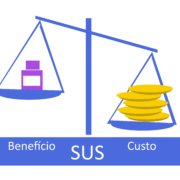Lançamento do selumetinibe

Recebi recentemente o convite do Laboratório AstraZeneca para participar do lançamento do medicamento selumetinibe no Brasil e para integrar como “expert advisor” um evento no qual será debatido o medicamento.
Respondi ao Laboratório AstraZeneca da seguinte forma:
Belo Horizonte, 8 de junho de 2021
À equipe técnica da AstraZeneca,
Recebi os convites para participar do evento publicitário de lançamento do selumetinibe no Brasil e para ser “expert advisor” num encontro sobre o medicamento em 30 de junho de 2021.
Quero agradecer e declinar de ambos os convites, porque tenho por norma pessoal não estabelecer vínculos profissionais (como, por exemplo, expert advisor) com quaisquer indústrias de medicamentos ou equipamentos médicos.
Além disso, parece-me que o folheto de divulgação do evento de lançamento do selumetinibe não é condizente com a realidade dos fatos observados no estudo da Dra. Gross e colaboradores ( VER AQUI ).
O selumetinibe não me parece ser o PRIMEIRO TRATAMENTO DA NEUROFIBROMATOSE, mas uma terapia com alguma possibilidade (50%) de reduzir o tamanho (30%) de neurofibromas plexiformes sintomáticos inoperáveis, um problema específico que ocorre em menos de 10% da população de pessoas com Neurofibromatose do tipo 1. Portanto, não me parece que o selumetinibe seja um tratamento no sentido amplo de cura ou solução definitiva de todos os diferentes problemas que a NF1 apresenta.
Neste sentido, nosso grupo do CRNF HC UFMG emitiu um parecer técnico sobre o medicamento e não creio que os dizeres da propaganda de lançamento do produto sejam coerentes com o que pensamos sobre ele ( VER AQUI ).
Além disso, enviamos dois temas livres para o encontro anual do Children’s Tumor Foundation (CTF), um evento patrocinado inclusive pela AstraZeneca, e nosso poster com críticas à eficácia do selumetinibe não foi aceito (apenas o poster com sugestões sobre como eventualmente usar o medicamento). (ver pôsteres anexos)
Desta forma, parece-me haver pouco espaço para questionamento sobre o medicamento selumetinibe nos eventos que estão sendo patrocinados pela AstraZeneca, os quais, obviamente se destinam a fazer propaganda comercial do medicamento.
Portanto, reservo-me o direito de declinar dos convites e permanecer com a opinião emitida em nosso parecer técnico e em nossa página da AMANF até que novos estudos científicos venham a modificá-la ( VER AQUI ).
Atenciosamente,
Luiz Oswaldo Carneiro Rodrigues
CRMMG 6725
POSTER 1 – RECUSADO
Title: Assessing the magnitude of clinical benefit of selumetinib as a treatment option for inoperable plexiform
Author: Rodrigues LO
Institution: Outpatient Neurofibromatosis Reference Center, Federal University of Minas Gerais, Brazil
Background: Around 30% of children with neurofibromatosis type 1 (NF1) present with plexiform neurofibromas (PN) and 50% of those are symptomatic and/or inoperable. MEK inhibitor selumetinib (SEL) has received FDA approval for PN treatment in this population, although it is not yet known if SEL can produce durable effects in symptoms or complications control or if it has meaningful impacts on overall survival or quality of life. Also, the balance among SEL clinical benefits, toxicity and costs have not yet been evaluated. Methods: We performed searches in Pubmed, Scielo, ClinicalTrials.gov and Google Scholar, aiming at high quality evidence to answer our clinical questions. The quality of the evidence, a measure of validity, was critically appraised using GRADE, that considers methodological aspects to estimate risks of bias. The magnitude of clinical benefit (MCB) was assessed using the evaluation forms of ESMO MCB scale (ESMO-MCBS) version 1.1, which considers the primary outcome, adverse events that impact on daily well-being and other patient-centered outcomes. Results: The best available evidence was an open-label phase II single-arm clinical trial and funded partially by the manufacturer of SEL, thus, it is of very low quality. The trial included 50 children with NF1 and heterogeneous PN (medians: 10,2 years old; 3 PN-related complications; tumor volume of 487 ml – range 5 to 3.820). Primary outcome (tumor response rate) occurred in 70% of participants but was not correlated with symptoms or quality of life improvements. Toxicity was high, with 28% of grade ≥3 adverse events, 14% of dose reductions and 10% of treatment discontinuation due to toxicity. Evaluation with ESMO-MCBS (through form 3, for single-arm studies in “orphan diseases” and for diseases with “high unmet need” when primary outcome is PFS or ORR) suggests magnitude level 3 (moderate), with no adjustments. Median estimated direct costs of SEL (based on the trial’s participants median body surface and treatment duration of SEL) were very high (US$ 430,000.00 per patient). Without a formal economic analysis, low cost-effectiveness of SEL could only be inferred. Conclusions: The best available evidence regarding the use of SEL in NF1 PN is of very low quality, which introduces considerable uncertainty in its estimated moderate magnitude of clinical benefit, at considerably high toxicity and financial costs. To face these results, we have proposed a clinical care protocol to be used with our NF1 patients (another abstract).
Authors: Rodrigues LO, Rezende NA, Cota BCL, Souza JF, Viana R, Corgosinho M, Rodrigues LOC.
References: Darrigo Jr. LG, et al., J Pediatr 2007;83(6):571-573; Prada CE, et al. J Pediatr. 2012;160(3):461-467; Gross AM, et al. N Engl J Med. 2020;382(15):1430-1442; ESMO-MCBS V1.1 EVALUATION FORM 3. Published 2020; Guyatt GH, et al. J Clin Epidemiol. 2011;64(4):407-415;
Granted by Associação Mineira de Apoio às Pessoas com Neurofibromatoses (AMANF) www.amanf.org.br. No conflicts of interest to disclosure.

POSTER 2 – ACEITO
Title: Clinical Care Protocol to use selumetinib as a treatment for inoperable plexiform neurofibromas
Presenting author: Rodrigues LO
Institution: Outpatient Neurofibromatosis Reference Center, Federal University of Minas Gerais, Brazil
Background: Children with neurofibromatosis type 1 (NF1) may present with symptomatic and inoperable plexiform neurofibromas (PN). The MEK inhibitor selumetinib (SEL) has been FDA approved as an option in that context. The pivotal trial (Gross et al. 2020) results suggest a moderate (level 3) Magnitude of Clinical Benefit on the ESMO scale (ESMO-MCBS v1.1, 2020), through the evaluation form used for single-arm studies in orphan diseases when primary outcome is a surrogate such as response rate (see another abstract). The evidence, though, is of very low methodological quality, according to GRADE (Guyatt GH et al. 2011). Moreover, SEL’s impact in patient-centered outcomes, such as overall survival, symptom control or quality of life (QoL), is uncertain. Evidence so far suggests that treatment might have to be continuous for a sustainable response. But, due to the lack of robust evidence on efficacy and safety of long term use of SEL in children, optimal treatment duration is unclear, atop possible effects of treatment discontinuation. Estimated direct financial costs of SEL seems high and it might not be cost-effective. This uncertainty around the real magnitude of net clinical benefit of SEL suggests that it should only be offered to patients in a careful informed-decision process, supported by care protocols. Methods: Our group have adopted a care protocol, including the following aspects: 1) PN’s features (location, volume, progression, symptoms, complications); 2) patient’s expectations with treatment (symptom control, volume reduction, cosmetic improvement, complication avoidance, pain control); 3) thorough didactic explanations to patients of the best available evidence, with the use of NF1-appropriate patient decision aids (including illustrated age-adjusted tools); 4) realistic estimations of possible results, updated during treatment; 5) active monitoring of anticipated adverse events; 6) impacts of SEL on patient’s daily well-being (objective measures of QoL); 7) timed reassessments of response, with defined clinical, imaging and laboratorial criteria; 8) clear criteria for treatment discontinuation; 9) definitions of maximum expected time for best response; 10) estimated duration of treatment; and 11) care-related patient’s financial costs. Conclusions: The current care protocol we are using and the systematic follow up of patients with SEL treatment for inoperable and complicated PN will generate real-world evidence on the actual clinical benefit of SEL to better inform patient’s decisions.
Authors: Rodrigues LO, Rezende NA, Cota BCL, Souza JF, Viana R, Corgosinho M, Rodrigues LOC.
References
Gross AM et al. N Engl J Med. 2020;382(15):1430-1442; ESMO-MCBS v1.1, EVALUATION FORM 3, 2020; Guyatt GH et al. J Clin Epidemiol. 2011;64(4):407-415; Institute of Medicine (US); Olsen LA et al. National Academies Press (US); 2011; Holmes‐Rovner, M. Health Expect. 2007 Jun; 10(2): 103–107.
Granted by Associação Mineira de Apoio às Pessoas com Neurofibromatoses (AMANF) www.amanf.org.br. The authors have no conflicts of interest to disclosure




